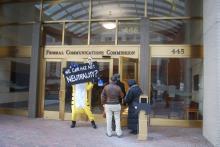
As Mayors must concern themselves with everything from public safety and health to the development of the local economy and the provision of essential municipal services, they tend to have a particular focus on the infrastructure necessary to support it all, amid a cacophony of competing interests.
Over the summer, having reached consensus on the fundamental importance of “the digital infrastructure of tomorrow,” a particular focus of the United States Conference of Mayors 88th National Annual Meeting was to issue a resolution declaring the necessity of “Preserving Local Public Rights-of-Way and Regulatory Authority to Most Effectively Deploy 5G Broadband Access and Bridge the Digital Divide during the COVID-19 Pandemic.”

The Mayors’ resolution comes in response to the Federal Communications Commission’s (FCC's) 2018 preemption of local governments’ authority to regulate 5G infrastructure in their cities.
At the heart of the regulatory debate: local governments’ ability to determine the amount of fees to charge mobile carriers that want to place 5G equipment in Rights-of-Way. In addition to putting limits on those fees, the FCC Order also sets strict timelines by which cities and towns must respond to carrier applications. The FCC decision, issued over the objections of industry observers and policy experts, essentially eliminates local communities’ ability to negotiate in order to protect their own Rights-of-Way and the poles, traffic lights, and other potential structures within those Rights-of-Way.
Preempting Local Authority
When the FCC handed down the order in the fall of 2018 we noted that it represented a significant giveaway to wireless carrier corporations while placing additional restrictions and undue financial burdens on local regulators, most of which are county boards and city departments.
To justify the order, the Republican-controlled FCC relied heavily on the misleading claim that application and attachment fees in larger communities are so excessive that they create a burden which prevents carriers from investing in rural communities. With the fee-caps in place, the FCC argued, it would allow wireless carriers to save and invest $2.5 billion in 5G infrastructure.
Former FCC Chief of Staff Blair Levin, one of the architects of the 2010 National Broadband Plan, however, exposed the fallacy of the FCC’s fee-cap argument, noting that “[e]ven if one accepts the FCC claim about the $2.5 billion—which is highly questionable—that amount is about one percent of what the FCC and industry claim is the necessary new investment needed for next-generation network deployments and, therefore, is not likely to have a significant impact.”
Moreover, the FCC order did not require mobile carriers to commit to expanded coverage in smaller communities, which prompted Next Century Cities to point out how “these low fees would create a de facto public subsidization of industry investment. … The FCC is just giving private wireless companies all of the benefits of a utility without any traditional public interest obligations.”
Consequences
The FCC order was challenged in court, however, the 9th U.S. Circuit Court of Appeals upheld the fee cap in an August ruling, despite the financial strain it is putting on local governments. In Milwaukee County, for example, where Verizon is applying for access to a mile-long route that runs across public park land to connect its infrastructure, county officials are feeling the squeeze.

"The truth is we’re being screwed by the State of Wisconsin by this ... our costs, we're the ones paying the staff, we’re the ones who go through our communities, we’re the ones who are going to have to review the licenses. And then we’re being told how much we can charge," said Sup. Sheldon Wasserman in response to the FCC corporate-friendly regulations.
5G (which can provide higher throughput to more connected devices in a given area) requires dense coverage to work. That means providers need to add lots of new transmitters and receivers onto existing poles. But, they will also need to add a host of new poles and the attendant fiber backhaul to support the network, something often overlooked in the touting of wireless 5G networks.
Locals residents have expressed concern that because each provider can build its own network of small cell site poles, it could soon lead to a forest of 30- to 50-foot tall towers around every public space and along the waterfront.
"As far as I can tell, it's corporate greed. Corporate takeover of our public spaces." Sup. Steven Shea added.
While state lawmakers in states like Illinois are considering legislation to give local governments more say in 5G wireless deployment, the U.S. Mayors resolution has fallen on deaf at the federal level.
“Our strategy and policies have not changed,” Larry Kudlow, who directs the White House National Economic Council, told the CTIA 5G Summit in a video keynote on October 27, according to prerecorded remarks. “President Trump directed me several years ago to maintain a free market approach; the president has not wavered.”
For more on the most common misunderstandings surrounding 5G and why the technology should be considered another tool rather than an exclusive remedy to connectivity challenges in the United States, see our Pocket Guide to 5G Hype. Then, listen to Episode 371 of the Community Broadband Bits Podcast, where Christopher talks with PC Mag's Sascha Segan about the technological, regulatory, and policy dimensions of 5G.









